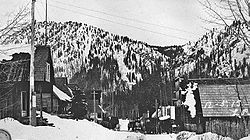Cornucopia, Oregon
| Cornucopia | |
|---|---|
| Ghost town | |

Cornucopia 1913
|
|
| Location in Oregon | |
| Coordinates: Coordinates: 45°00′30″N 117°11′34″W / 45.0082°N 117.1927°W | |
| Country | United States |
| State | Oregon |
| County | Baker |
| Elevation | 4,741 ft (1,445 m) |
| Time zone | Pacific |
Cornucopia is a ghost town built during the gold mining boom of the 1880s in Eastern Oregon, United States. The town was officially platted in 1886 and was a mining town with various levels of success until it was abandoned in 1942. It is now primarily a tourist attraction as a ghost town. It is located east of Baker City high in the mountains of Pine Valley almost due north of Halfway, Oregon, on Oregon Route 86.
In 1884 a man by the name Lon Simmons discovered gold on the far east edge of Oregon. By July 1885 there were at least 500 men living in the area, forming a town that became known as Cornucopia. The name means "Horn of Plenty," which was appropriate due to the large amount of gold discovered. The town only continued to grow as wealth flowed out of the area. The primary mining companies were Last Chance, Queen of the West, Union-Companion, and the Red Jacket. In 1902 the Oregon Daily Journal claimed that “the Cornucopia group of gold mines contains what is probably the largest ore body in the Pacific Northwest, if not in the United States”. Around the same time there were up to 700 men working for the mining company Cornucopia Mines of Oregon, making it the 6th largest mining operation in the United States at the time. However, the mixture of old equipment and horses being the only form of transportation greatly hindered the town’s success. In the same year, for unknown reasons, the mining companies neglected to pay a collective $40,122 dollar engineering bill. This caused foreclosure proceedings and affected the mine's success until the claim was settled in February 7, 1905, allowing the mine to grow again.
There were large gold strikes in both November 1915 and towards the end of 1921, which kept the town booming. Technological advances such as electricity, pneumatic drills, and the railroad expanding to be along the Snake River all occurred in early 1922. These advances combined with the late 1921 gold strike allowed a massive mill to be constructed. This mill was considered a twenty-stamp mill, meaning it had twenty giant hammers used to crush ore, and could produce 60 tons of ore each day. This crushed ore was then put through a chemical treatment that extracted the gold.
However, the wall street crash of 1929 even affected a mining town in Oregon. Mining was halted and people left town. By 1930 the census stated that only 10 people currently lived in Cornucopia. Although, it only took a few years for the mining plants to open back up again, and by 1934 the mines were processing gold once again. By 1938 the mining company was raking in money, making a profit of $100,000 in September (Equivalent to $1,727,681 on 3/20/2017). The mines continued to grow more as time went on; Cornucopia was responsible for 66% of the gold in Oregon in 1939. The census in 1940, just 10 years after the town was practically deserted during the beginning of the great depression, enumerated 352 people and the mines were the 7th largest in the nation. However, in the beginning of 1942 President Roosevelt closed all gold mining operations in American so that miners could focus on producing metals for war. The town became abandoned and never recovered.
...
Wikipedia

